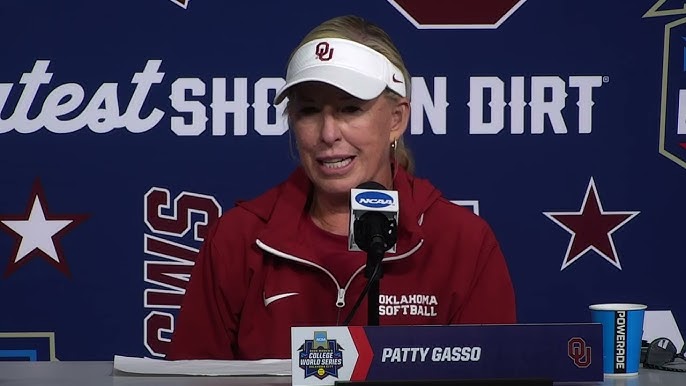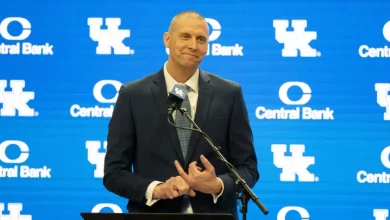OU Softball: Patty Gasso Advocates for Change to the WCWS Format

For decades, the University of Oklahoma softball program has stood as a powerhouse on the national stage. At the helm of this success is Head Coach Patty Gasso, a Hall of Fame leader known not only for guiding the Sooners to multiple national championships but also for her forward-thinking approach to the sport. Recently, Gasso has stepped into the spotlight advocating for a reevaluation and change to the Women’s College World Series (WCWS) format, sparking conversation across the collegiate softball landscape about how best to crown a national champion while balancing fairness, competitiveness, and athlete welfare.
The WCWS, which serves as the culmination of the NCAA Division I softball season, brings together the top eight teams in the country to compete in a high-stakes tournament that determines the national champion. Since its inception, the WCWS has grown tremendously in popularity and prestige, showcasing some of the best athletes and most exciting moments in college sports. However, as the sport evolves, so too do the demands on players, coaches, and programs. It is within this context that Gasso’s call for change has emerged, fueled by a desire to ensure the tournament remains sustainable, equitable, and reflective of the sport’s growth.
Gasso’s advocacy is rooted in years of experience navigating the intense pressures of postseason play. Under her leadership, the Sooners have made numerous WCWS appearances and captured multiple national titles, affording her a unique perspective on the tournament’s strengths and its limitations. While acknowledging the prestige and excitement the current format brings, she has highlighted areas where the structure may no longer serve the best interests of the teams and athletes involved.
The current WCWS format features an eight-team double-elimination bracket, followed by a best-of-three championship series between the final two teams. This format, while dramatic and viewer-friendly, can present significant challenges, particularly in terms of scheduling, player fatigue, and competitive balance. The nature of double elimination means that teams can play multiple games in a short span, often requiring pitchers to take the mound on back-to-back days or even multiple times within 24 hours. This intense workload raises concerns about injury risk and the overall health of the athletes.
Additionally, the format sometimes creates uneven rest periods between games, as teams coming through the losers’ bracket are forced to play more games in a condensed timeline compared to teams advancing undefeated. This disparity can influence outcomes, potentially skewing the fairness of the competition.
Gasso has been vocal about these concerns, emphasizing the importance of athlete welfare. “Our players work incredibly hard all season long, and they deserve a postseason that not only challenges them competitively but also respects their health and well-being,” she stated in a recent interview. “We want to see the best softball played, but not at the expense of our athletes’ safety or long-term careers.”
Beyond physical demands, Gasso has also discussed how the current format affects coaching strategies and team dynamics. The compressed schedule and high stakes often force coaches into difficult decisions about pitcher usage, lineup rotations, and risk management. While these tactical elements add drama to the tournament, they can also detract from the pure competitive meritocracy that many believe the national championship should embody.
In light of these challenges, Gasso has proposed exploring alternative formats that could address these issues while preserving the excitement of the WCWS. One potential solution she has mentioned is the implementation of a pool play system, similar to what is used in other NCAA championship tournaments like volleyball or basketball. Pool play would allow teams to compete in round-robin groups, ensuring each team plays multiple games over several days with more balanced rest periods.
Such a format could reduce the physical strain on players, as teams would have more predictable schedules and fewer do-or-die games in rapid succession. It also enhances fairness by allowing teams a chance to recover from an early loss without facing immediate elimination, potentially leading to a truer determination of the best team over the course of the tournament.
Critics of changing the format often point to tradition and the dramatic tension that double elimination provides. The current structure creates a narrative of redemption and resilience as teams battle through the losers’ bracket, often resulting in some of the most memorable moments in college softball history. Fans and broadcasters alike value this tension, which can culminate in thrilling, high-pressure games.
However, Gasso argues that tradition should not be a barrier to progress. “We owe it to the sport to evolve,” she insists. “Other NCAA championships have successfully transitioned to formats that better serve their athletes and their audiences. Softball should be no different.”
The conversation about WCWS format reform also ties into broader discussions about the growth of women’s college softball. With increasing investment in facilities, coaching, and media coverage, the sport has seen rapid development, attracting top-tier talent and expanding its fan base. As the game grows, so do expectations for how championships are conducted—expectations for fairness, player safety, competitive integrity, and spectacle.
Gasso’s stance resonates with many coaches, players, and administrators who are keenly aware of these shifts. Some have echoed her call for a reevaluation of the tournament structure, emphasizing the need to adapt to the sport’s evolution. Others have suggested incorporating additional rest days into the schedule or expanding the tournament field to allow more teams to participate in a more balanced format.
In response to Gasso’s advocacy, NCAA officials have indicated a willingness to study the issue further. While no official changes have been announced, the dialogue around the WCWS format is gaining momentum, fueled by voices like Gasso’s that bring credibility and urgency to the conversation.
The potential benefits of reforming the WCWS format extend beyond athlete welfare. A revised structure could enhance competitive balance by reducing the impact of luck and scheduling quirks on outcomes. It might also increase fan engagement by providing more guaranteed games for each team, enabling supporters to see their favorite teams compete multiple times regardless of early losses.
From a media perspective, a format with predictable scheduling and more marquee matchups could offer greater opportunities for broadcast partners and sponsors. This, in turn, would support the continued growth and visibility of women’s college softball at the national level.
As the conversation progresses, it is clear that any changes to the WCWS format will require collaboration among the NCAA, member institutions, coaches, players, and other stakeholders. Balancing the interests of all parties is essential to crafting a format that enhances the sport’s integrity and appeal without compromising its traditions.
Patty Gasso’s advocacy is a catalyst in this process. Her stature within the sport and her track record of success give weight to her proposals, encouraging constructive dialogue and thoughtful consideration. Her commitment to the players’ experience and the game’s future embodies the leadership needed to guide softball into its next chapter.
Looking ahead, the evolution of the WCWS format could mark a significant milestone in the maturation of women’s college softball. As programs like Oklahoma continue to elevate the game, ensuring that postseason competition aligns with modern standards of fairness, safety, and excitement will be paramount.
In the meantime, fans and participants alike can expect spirited debate and ongoing analysis as the NCAA evaluates potential reforms. For coaches like Gasso, the goal remains clear: to create a championship experience worthy of the sport’s incredible talent and passion, one that honors tradition but embraces innovation.
In summary, Patty Gasso’s call for change to the WCWS format highlights important considerations for the future of college softball. Her focus on athlete welfare, competitive fairness, and the evolving landscape of the sport offers a thoughtful blueprint for reform. Whether through pool play, expanded rest, or other structural adjustments, the path forward promises to make the WCWS an even more compelling and sustainable showcase of collegiate softball excellence.
As the sport continues to grow, the voices of leaders like Gasso will be crucial in shaping a tournament that reflects the values and aspirations of all who love the game. The future of the WCWS, and women’s college softball more broadly, stands at an exciting crossroads—one where tradition meets transformation under the guidance of visionary advocates ready to push the sport to new heights.









